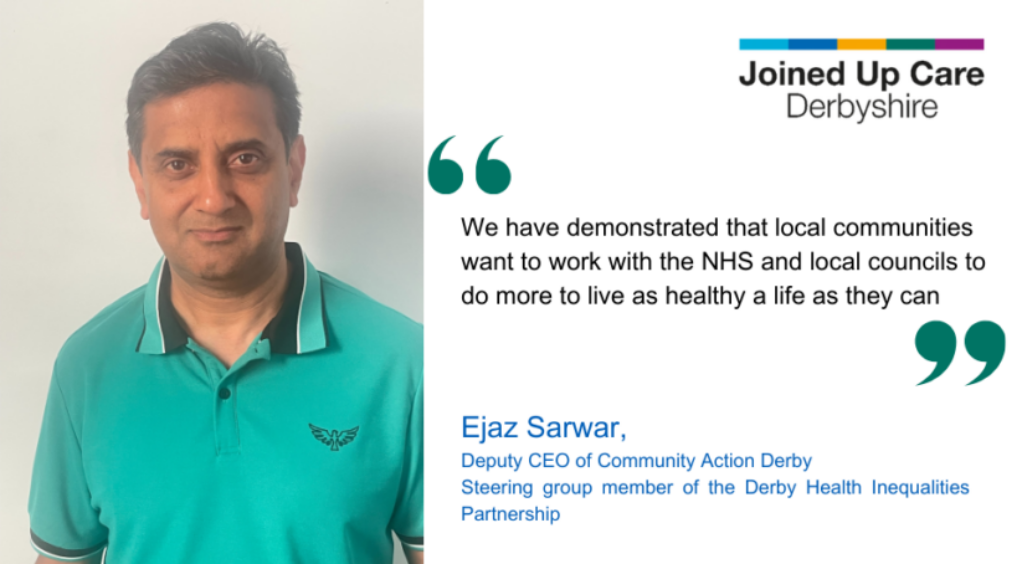Ejaz’s blog: How our communities are helping to beat “the silent killer”
By Ejaz Sarwar, Deputy CEO of Community Action Derby and steering group member of the Derby Health Inequalities Partnership
Minority communities in Derby and Derbyshire – like elsewhere – are affected by health inequalities.
In stark terms, people from minority communities tend to get sicker earlier in life, to live more years of their life with ill health and to die at a younger age.
This was particularly highlighted by the covid pandemic.
During the pandemic, the NHS and local councils worked hard to build trust with minority communities, adapting their ways of working, such as bringing vaccination centres into community centres.
At Community Action Derby, we set up the Derby Health Inequalities Partnership (DHIP), alongside Derby City Council (Public Health), to build on the amazing community response to the pandemic and work with communities to help achieve better health outcomes going forward.
Post pandemic, inequalities in health remain a burning issue and we need to maintain that sense of urgency and drive in overcoming them.
Therefore, when we were approached to work with the local NHS to increase the number of blood pressure checks carried out in our communities, we were keen to take part.
High blood pressure has been reported in almost 70% of stroke patients and it causes half of all heart attacks, but it has no noticeable symptoms, which is why it’s called “the silent killer”.
Evidence has also shown that people of Asian or Black and African Caribbean heritage are at higher than average risk.
Today, in partnership with the local NHS, I attended the board of NHS Derby and Derbyshire to tell them about the high blood pressure project, what we did and what we learned.
I spoke alongside Jas Kaur, who is an expert in medicines, and Beth Fletcher, who supports the NHS to engage with local communities.
Through DHIP we have a network of “Community Connectors”, who are volunteers acting as a liaison point between their community, local voluntary organisations and local service providers.
The Connectors are fantastic as they help to take messages, including those from the NHS, to communities who often would not hear it any other way. They communicate in a positive, realistic and sensible way, making them easy to approach and trusted by the community.
When the high blood pressure project started, we wanted to make sure that the Connectors also had all of the skills, knowledge and resources needed to feel confident in taking part in the project.
NHS staff came into our communities to listen to what the Community Connectors wanted, so they could share the message effectively themselves.
Through the Derby Health Inequalities Partnership, we worked together, with small amounts of funding, to produce information and take it to communities in a culturally specific way.
We worked with young people so they could pass the information on to their parents and elders, and we ran information sessions at the Pakistan Community Centre in Derby and the Derby West Indian Community Association.
The NHS badge is very powerful and, joined together with the community-trusted brands of DHIP and Community Action, people listened and took notice, whether in a community centre, at their local GP practice, or in the community pharmacy.
During last autumn 4,113 people at high risk had their blood pressure checked by GPs, pharmacists and trained Community Connectors in Derby.
As a result more than 1,228 high or very high blood pressure readings were recorded.
Local GP practices did checks on 3,224 patients and Community Connectors gave 909 blood pressure checks, smashing their target of 400.
The Connectors have continued to give regular blood pressure checks at a range of events and organisations, and a further 257 blood pressure checks were recorded from November 2023 to April 2024.
People whose readings are high are offered advice and support to reduce their risk of the potentially devastating or fatal consequences of cardiovascular disease such as heart attack or stroke.
If a GP makes a diagnosis of high blood pressure, then they are also likely to prescribe medication that will reduce the risk of heart attack or stroke.
Our local communities, community organisations and volunteers are doing fabulous work to keep people healthy – through exercise classes, walking groups, healthy eating guidance and drop-in advice sessions on a whole range of health issues.
They are also supporting people to identify the risk factors for common killers like heart disease, stroke and cancer, and to help identify the signs and symptoms that should encourage a visit to the GP practice or pharmacy.
This project has demonstrated that local communities want to work with the NHS and local councils to do more to live as healthy a life as they can. However, those communities need investment to support them, and they need to be involved in the process of planning how NHS and council resources are used.
At Community Action and DHIP, we are incredibly proud of what we, and our Connectors, have achieved in partnership with the NHS through this project.
The collaborative approach has shown how effective it is for the NHS and community partners to work together to achieve, and even exceed, community engagement for this type of work. We look forward to collaborating again on another project soon!
You can read more blogs from key voices across our system, on our website.

